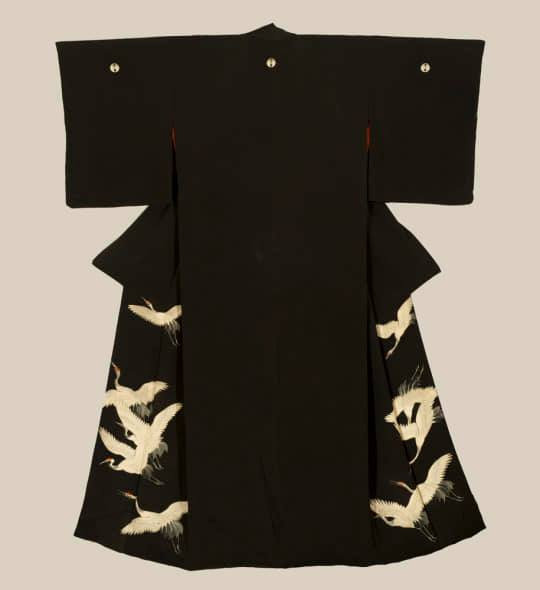Four Meiji period 'Crane' kurotomesode from The Kimono Gallery
Yuzen-dyed Kurotomesode. Mid to late Meiji period (1880-1911), Japan. The Kimono Gallery.
A chirimen silk kurotomesode featuring a flock of yuzen-dyed flying cranes over a raging wave. Silver foil highlights. Five mon (family crests). The Japanese regard the white crane as the premier symbol of longevity and good fortune. What sets this formal kimono apart from other tomesode is the high level of its artistry. The carefully shaded blue wave with white froth contrasts against the uniform black background. The flock of cranes form an elegant arc in the same direction as the wave. Most of the artwork is consciously compressed against the left side of the kimono, for a dynamic effect that proves that a kimono can be a great canvas for an artist.
A large and striking ‘chirimen’ (crepe) silk antique kurotomesode featuring elegant cranes and paulownia masterfully created with yuzen-dyeing, sagara knot and simple embroidery. Late-Meiji period (1890-1911), Japan. The Kimono Gallery.
A silk kurotomesode featuring elegant flying cranes accomplished with yuzen-dyeing and embroidery highlights. Late Meiji period (1880-1911), Japan. The Kimono Gallery.
A silk kurotomesode featuring yuzen-dyed cranes and bamboo by a deep blue river. Late Meiji period (1880-1911), Japan. The Kimono Gallery.

/https%3A%2F%2Fprofilepics.canalblog.com%2Fprofilepics%2F1%2F0%2F100183.jpg)
/https%3A%2F%2Fstorage.canalblog.com%2F03%2F02%2F119589%2F96711876_o.jpg)
/https%3A%2F%2Fstorage.canalblog.com%2F11%2F31%2F119589%2F94773502_o.jpg)
/https%3A%2F%2Fstorage.canalblog.com%2F20%2F83%2F119589%2F94772815_o.jpg)
/https%3A%2F%2Fstorage.canalblog.com%2F26%2F72%2F119589%2F75604929_o.jpg)
/https%3A%2F%2Fstorage.canalblog.com%2F59%2F60%2F119589%2F26458628_o.jpg)










/http%3A%2F%2Fstorage.canalblog.com%2F72%2F32%2F119589%2F128696867_o.jpg)
/http%3A%2F%2Fstorage.canalblog.com%2F91%2F49%2F119589%2F122062311_o.jpg)
/http%3A%2F%2Fstorage.canalblog.com%2F91%2F64%2F119589%2F122061968_o.jpg)
/http%3A%2F%2Fstorage.canalblog.com%2F84%2F40%2F119589%2F122061837_o.jpg)